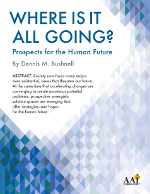AAI Foresight has published two new white papers, excerpted below, for its Foresight Report series. Readers are welcome to download the reports for free or share links to the download pages; for permission to reprint the reports, please contact the respective authors.
After Brexit: A Nuclear Wild Card
By Joergen Oerstroem Moeller
The result of the Brexit vote depicts a revolt staged by ordinary people left behind, neglected, and coaxed by the elite unable to deliver on the promise of economic globalization as a golden age. Now there is a somber aspect lurking behind the curtain. The Brexit debate has unleashed political views hitherto taboo. Regressive nationalism, populism, xenophobia — yes, racism — and violence. Le Front National in France and similar political forces in other European countries have opened the door, but the Brexit debate has given it another and more sinister dimension.
The risk is not referenda in other European countries, but a revival of political forces reminiscent of the 1930s — extremism legitimizing oppression of people who think “otherwise.” If those forces are let loose, encouraged and boosted by the Brexit debate, Europe faces an existential crisis already visible over recent years with the refugees and migrants, but now exploding.
Within the U.K., one wild card is the nuclear deterrent.
The lifetime of the existing nuclear deterrent, four Vanguard-class nuclear submarines, expires around 2028, which in view of planning and procurement puts a decision on replacement on the agenda in 2016. The force is based in Scotland.
The official estimate for replacing the fleet is $44 billion, but unofficial estimates go as high as $235 billion. The Ministry of Defense has mentioned 6 percent of the annual defense budget — a somewhat cryptic message in view of uncertainties about future defense budgets and the length of investment.
It is one of the few issues still uniting the Tory party. Almost the first major political step by new Prime Minister Theresa May was to push this item in an effort to show that, on a key issue, the party is united and resonates with the sentiment among many Brexit voters, while at the same time displaying Labor’s division. This tactic paid off. On July 19, the House of Commons voted overwhelmingly to renew the Trident system. Only one conservative voted against. The opposition leader, Jeremy Corbyn, against the program, was once again humiliated, with three-fourths of Labor MPs supporting the government.
However, tactic is one thing, strategy another. The economy may throw grit into the machinery. Falling economic growth may soften the Tory determination and run counter to Prime Minister May’s apparent move toward the political center by forcing her to choose between Trident and social welfare of prime importance to many voters.
An unknown factor is the attitude of Scottish National Party (SNP), which has hitherto promised to rid Scotland of nuclear weapons. If Scotland votes to leave the UK and SNP maintains its view, new facilities need to be constructed in England, adding to the already exorbitant costs. A Scottish exit from the UK will trigger tumultuous negotiations about future England–Scotland relations, and the nuclear base will be a pawn in this game.
The problem for Britain’s defense forces is not so much the prospect of a European army drawn into the debate by the “leave” camp — attractive for some, repellent for others — but that the money is not there.
Meanwhile, after some hesitation and pondering about what course to take, France and Germany will in one way or another announce a stronger integration in key areas such as the single currency (euro) and defense. The door will be open for other member states to join, but without derogations, exemptions, and special agreements. Over the years, the British and the French have tried to step up cooperation, but with limited success. The two costly weapons systems — nuclear deterrent and carrier strike groups — look tantalizing for cooperation in the eyes of everybody but policy makers and top brass. To imagine a revival of such efforts in the slipstream of Brexit appears fanciful.

Joergen Oerstroem Moeller
Joergen Oerstroem Moeller is former State-Secretary, Royal Danish Foreign Ministry (1989-1997). He is visiting senior fellow, ISEAS Yusof Ishak Institute, Singapore, and adjunct professor, Singapore Management University & Copenhagen Business School. He may be reached at joergen@oerstroemmoeller.com.
Excerpted from “Forecasting After Brexit” by Joergen Oerstroem Moeller (AAI Foresight, 2016). Download PDF.
Halophyte Cultivation and Prospects for the Human Future
By Dennis M. Bushnell

Since the beginning of the Agricultural Age, various civilizations have exploited and outgrown or polluted their local resources, forcing them to move on and exploit other territories and resources. A classic example is the Sumerians, whose agricultural fields became salinated — a phenomenon being repeated now as the aquifers we are pumping become increasingly saline. We are repeating the cycle of overusing or altering the resources we live on, but now we are overusing or polluting nearly the entire planet’s ecosystem with no obvious new lands to move to.
However, there are yet planetary resources that could stave off Malthus for a while longer. This may be sufficient to enable humans to accelerate their own evolution at a pace many orders of magnitude faster than natural evolution.
At the same time, major social changes can be expected as a result of the impacts of numerous converging technological developments. We are well on our way to significantly altering our physiology and then, perhaps in the farther future, eschewing our physiology completely.
First, the givens: We inhabit a finite planet with finite resources and ecosystems. Until recently (and largely still), the human enterprise was one of broad-scale slash and burn — trash here and then move on to trash elsewhere. Much of human econometrics is based upon growth, and we have reached the point where, in terms of population size and demands upon the ecosystem, we have driven that system into deficit. As populations continue to grow, so will their demands, as the future billions strive to improve their standards of living. The shortfall of resources to meet those accelerating demands may be the equivalent of three planets, some have estimated. Therefore, the growth mantra will, at some point, have to switch to a sustainability mantra, with major impacts on geopolitics and national security as well as econometrics.
The other major given is the innate cleverness of the human animal to subvert or delay Malthus and to invent and deploy technology to enable the continued growth humans seem to seek.
An Emerging Solution Space: Halophyte Cultivation
Halophytes could provide both energy and food for the future. There are some 10,000 natural halophytes — plants that are tolerant to saline agricultural land. Many will grow reasonably well using direct seawater (no desalinization needed), even before we introduce advanced genomics. These plants could produce nearly all that glycophytes (freshwater plants) now produce.
Among the immense advantages of switching to halophytes are that saline-tolerant plant biomass uses what we have a surfeit of (and what could be our last major play regarding the ecosystem): wastelands, deserts (44 percent of the land area), and seawater (97 percent of the planet’s water resources). Seawater contains about 80 percent of the nutrients needed to grow plants, and researchers are developing new techniques to extract nitrogen from the air, thus requiring little fertilizer.
Halophyte cultivation for food would free up the 70 percent or more of the freshwater we use for conventional glycophyte agriculture, and which we are now running out of for direct human use, thus solving both water and food problems. And cultivation of halophyte biomass would similarly obviate the use of arable land and freshwater for biofuels and provide petrochemical feedstocks for plastics and other industrial products. It is literally “green energy” and chemicals.
Overall, halophyte cultivation and development could address our interrelated land, water, food, energy, and climate problems. While this approach does not solve such problems as income disparity or machines taking over jobs, it would provide society some breathing room and push Malthus downstream by perhaps a century or more, thus alleviating many societal issues in a synergistic fashion.

Dennis M. Bushnell
Dennis M. Bushnell is chief scientist at NASA Langley Research Center, where he is responsible for technical oversight and advanced program formulation. He may be reached at dennis.m.bushnell@nasa.gov.
Excerpted from “Where Is It All Going? Prospects for the Human Future” by Dennis M. Bushnell (AAI Foresight, 2016. Download PDF.
Calls for Futurists
• 50:50 - Scenarios for the Next 50 Years, to be published on March 1, 2017 (Future Day), by Fast Future Publishing, seeks chapter proposals from both new and established futurists. Suggested topics include macro perspectives on the future, demographics, values and beliefs, civil society, governance and legal systems, peace and conflict, business, energy and the environment, and science and technological innovation. “The intention is to publish 50 views on the next 50 years from 50 different future thinkers around the world,” says publisher Rohit Talwar. View guidelines here. Submit proposals (deadline October 24) here.
• The Design Management Academy Conference 2017, to be hosted by the School of Design at the Hong Kong Polytechnic University, seeks papers and session proposals on the theme “Research Perspectives on Creative Intersections.” The conference, to be held June 7-9 in Hong Kong, will focus on seven meta themes: new models of innovation, product-service systems, policy making, intersecting perspectives, methods, capabilities, and foundations. Submission deadline is November 15. Learn more here.
• Knowledge Futures: International Journal of Futures Studies published by the Centre for Knowledge Futures at the University of Management and Technology in Lahore, Pakistan, seeks papers on a variety of futures-related subjects, including artificial intelligence and anthrobotics, bioinformatics and genomics, cosmology and astrobiology, disruptive technologies, the Singularity, neuroepistemology and neuroethics, sustainability and alternative futures, speculative studies and science fiction, and more. Deadline for submissions is November 30. Learn more here.
Fueling Freedom: Alternatives to Alternatives
Book Review by Randall Mayes
The next U.S. president will inherit an estimated $20 trillion national debt. Polling reveals that voters are most concerned about jobs, the economy, and terrorism, while global warming is much lower on the list of priorities. However, climate and energy policies will have a major impact on these issues.

In Fueling Freedom: Exposing the Mad War on Energy (Regnery, 2016), authors Kathleen Hartnett White, director of the Armstrong Center for Energy and the Environment at the Texas Public Policy Foundation, and Stephen Moore, a former Wall Street Journal reporter and economist at the Heritage Foundation, examine the prospects of renewable energy and fossil fuels as viable paths for meeting future energy demands.
Given that U.S. voters overwhelmingly favor economic growth and energy security over climate control, the authors argue that fossil fuels and market-driven advances to abate greenhouse gases provide the most logical path forward.
Over the past several decades, the green energy movement became fashionable because of the belief in peak oil and the prospect of reaching the tipping point for global warming. This led to a global push to promote alternative energy sources. However, today fossil fuels still supply over three quarters of global energy demands.
Those advocating alternative energies have argued that, when the social costs of fossil fuels — the effects of climate change and health impacts — are not included in cost-benefit analyses or in prices at the pump and for electricity, the benefits of fossil fuels to society are inflated. The authors counter that it is only fair to also factor in the social benefits of fossil fuels to legitimately compare the two energy strategies.
Humans utilized wind and water wheels thousands of years ago, but these technologies were not scalable or reliable. Consequently, human labor and farm animals were the major source of power for most of human existence. In 1800, more efficient fossil-fuel-powered machinery ignited an Industrial Revolution in Great Britain. The Industrial Revolution has provided a significant rise in the standard of living and growth of the middle class. For many, coal power and steam engines reduced the workweek from 72 to 40 hours and has subsequently reduced the amount of disposable income spent on subsistence from 74 percent to 13 percent today. As a result, real incomes have risen by a factor of nine.
More recently, the shale revolution has brought billions of people out of poverty and raised the living standards for many others. Jet and gasoline engines have revolutionized transportation on land, in the air, and on the seas. With the rise of suburbs in the United States, housewives became the envy of the rest of the world with their station wagons, modern kitchens, and numerous household appliances.
The authors argue that, ironically, progressive energy policies utilizing renewable energy are actually regressive for developing societies. There is a moral case for fossil fuels since green policies restrict the most efficient power sources for transportation, food, materials, heat, and cooking in the developing world.
In the future, it is unlikely that countries will be able to power trillion-dollar economies with solar and wind power. The U.K., Germany, China, and the U.S. have all subsidized green energy and set mandates to reduce the use of fossil fuels. Despite nudges and subsidies to make renewables economically viable, these countries have all experienced green bubbles.
Energy Security and Independence
While people were once indoctrinated to think that the Earth is running out of fossil fuels — the conclusions of The Club of Rome’s 1972 study Limits to Growth — peak oil never materialized. Rather, oil has become relatively cheap. Quoting from Matt Ridley’s, The Rational Optimist, the authors point out that, even with population growth, fossil fuels are abundant enough to generate wealth for the whole planet. The United States alone has an estimated $50 trillion worth of oil and gas reserves, according to the International Energy Agency.
Taking advantage of these reserves could provide a path for economic growth, get the United States back on track for a desired 4 percent growth rate, fund infrastructure upgrades, and reduce the federal deficit. Instead of boosting the economies of Iran, Russia, Venezuela, and Libya, the United States could actually export oil and gas using these reserves.
California and Texas both have vast oil and gas reserves. Texas embraces the oil industry and is rich, while California embraces green energy and at times has struggled financially to pay its schoolteachers and government employees. Developing California’s reserves could help with the state’s solvency issues.
To address global warming, the authors believe we should not underestimate the ability to solve problems through market-generated innovation for a long-term solution. Market forces have made abundant natural gas affordable. Advances in fracking technology have lowered methane emissions into the environment.
Research by Google reveals that the physical requirements necessary to develop the infrastructure for solar and wind reliance are not practical. The amounts of acreage, steel, and cement needed and questionable sustainability benefits have convinced Bill Gates to shift investments with his foundation from alternative energy to breakthrough research technologies.
The authors are critical of an economic system that enables Elon Musk to receive billions of dollars in taxpayer subsidies for SolarCity, SpaceX, and Tesla. However, in the case of SpaceX, Musk realizes that, even with an efficient and sustainable energy source, it will become necessary to terraform other planets at some point in the future. With or without the Anthropocene period and increased carbon and methane emissions, the Earth’s temperature will inevitably rise as it has numerous times throughout history. In many cases, it is expensive and a losing battle to fight Mother Nature.
Authors White and Moore provide a service supplementing the alternative energy movement perspective with an alternative: fossil fuels and technological innovation driven by markets. For the next president and other policy makers, Fueling Freedom provides an in-depth discussion of many topics unlikely to be included in a compilation of policy memos from staff members. For other readers, it will help develop more informed opinions on energy policy decisions.
Randall Mayes is a technology analyst and author of Revolutions: Paving the Way for the Bioeconomy (Logos Press, 2012). He may be contacted at randy.mayes@duke.edu.
Signals: artificial general intelligence, economics, energy, neuroscience, robotics

